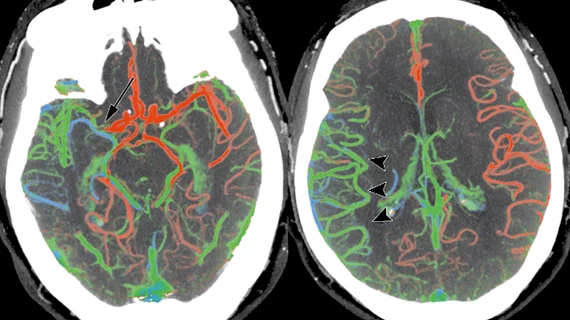Because cerebral vessels are smaller and potentially more fragile in women than in men, future research into mechanical clot removal for stroke treatment should be “sufficiently powered to detect sex-specific differences in neuroimaging profiles and treatment techniques.”
What’s more, imaging variables and treatment complications “should be reported for both sex strata, particularly when there is reason to expect sex-specific differences.”
The recommendations are from the American Heart Association, which has issued a wide-ranging scientific statement recommending such differentiation across myriad stroke-care and -research scenarios.
Stroke, the flagship journal of the AHA’s American Stroke Association, published the document online June 13 [1].
In introducing the forward-looking statement, lead author Johanna Ospel, MD, PhD, senior author Mayank Goyal, MD, PhD, and colleagues note that outcomes of mechanical clot removal—aka endovascular treatment (EVT)—are highly dependent on the timeliness of the intervention as well as on baseline epidemiological variables.
There is no reason to expect substantial differences between men and women in these regards, they add, yet “it is beyond doubt that aspects of pre-EVT and post-EVT management are influenced by patients’ sex.”
Sex and Gender Differences in EVT: Explorable Unknowns
The authors emphasize the importance of keeping in mind that most EVT studies, including the research underpinning the present scientific statement, “report patient sex rather than gender, although some of the reported differences may be truly related to gender rather than sex. Improving our understanding of sex- and gender-specific differences will help clinicians tailor management strategies better to individual patients and thereby improve their functional outcome.”
Toward that end, Ospel and colleagues briefly consider four aspects of EVT care in particular and, more generally, of care for acute ischemic stroke in general.
Forward-looking scientific inquiries could go far, the authors suggest, toward helping show whether, to what extent, why and how these “unknowns” are influenced by the sex of the patient:
Unknown No. 1: Does the Optimal EVT Technique Differ Between Men and Women?
Cerebral hemodynamics seem to differ between men and women and show menopausal dynamics that are unique to women, raising the question of whether EVT selection criteria and techniques could be improved by accounting for sex-specific differences in cerebrovascular pathophysiology. That being said, there currently are no robust data to suggest that patient sex per se influences technical EVT success.”
Unknown No. 2: How Does Sex Influence Post-EVT Outcomes?
Evidence suggests that women experience less pain and discomfort compared with men after EVT, which is only moderately associated with the Modified Rankin Score (mRS) because the mRS is heavily weighted on motor function and does not capture discomfort and anxiety. Poststroke depression, on the other hand, is more commonly seen in women. … Use of patient-reported outcomes can help to capture post-EVT outcomes and the influence of sex in a more comprehensive, multidimensional way.”
Unknown No. 3: How Can the Influence of Sex and Gender Be Differentiated?
Clearly, the greatest value of distinguishing sex versus gender in acute stroke lies mostly in the ability of those variables to help disentangle biological versus socioculturally determined factors contributing to EVT differences, regardless of whether patients are cisgender or transgender. Of note, even if patient gender is not explicitly captured and reported, many studies contain information on gender-related variables such as social support networks, marital status, type of occupation, and education level, and these could be used as a starting point for gender-specific research.”
Unknown No. 4: How Does Sex Influence Access to EVT?
[I]n North America and Europe, female patients are less likely to complete investigations for secondary stroke prevention measures during their admission, have shorter hospital lengths of stay than men, are more likely to receive palliative care consultation and are less likely to be offered acute rehabilitation services. The exact extent of under-diagnosis and undertreatment with EVT and the role that sex plays in this regard are unknown at this time, but according to the few available data, further studies on this topic are highly warranted.”
Looking further ahead, Ospel et al. state the biggest challenge in improving medicine’s understanding of sex-related differences in EVT “is probably not related to the patients who are treated but rather lies in determining sex-related access barriers to EVT, that is, determining how many men and women who could benefit from EVT lack access to this highly effective treatment in our own hospital, state, and country and on a global scale.”
The authors composed the statement on behalf of the American Heart Association Stroke Council, the Council on Cardiovascular Radiology and Intervention, and the Council on Epidemiology and Prevention:
The journal has posted the study in full for free (PDF), and the AHA has posted a summary news release with links to additional resources here.
More Coverage of Stroke Care:
FDA warns providers about potential misuse of imaging-based software for stroke triage
VA telestroke program prevents unnecessary hospital transfers and improves rural outcomes
Disparities evident as CT stroke imaging rises sharply over 7-year period
4 increasingly common uses for imaging AI in the ED
Reference:
- Johanna Ospel, Mayank Goyal et al., “Toward a Better Understanding of Sex- and Gender-Related Differences in Endovascular Stroke Treatment: A Scientific Statement From the American Heart Association/American Stroke Association.” Stroke, June 13, 2022. DOI: https://doi.org/10.1161/STR.0000000000000411

